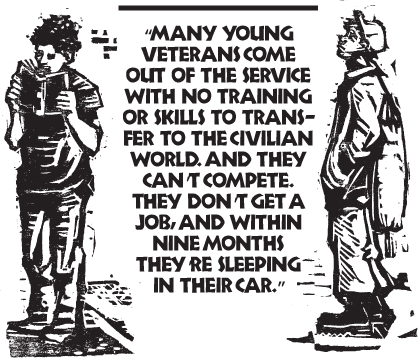 |
||||||||||||
|
November/December 2013
BY DAVE TARRANT The homeless come from all walks of life, including the ranks of veterans. In Dallas, Ken Watterson discovered that fact five years ago after starting a free van service to help bring Iraq and Afghanistan War veterans to medical appointments. Watterson, a Marine Vietnam veteran, quickly realized that many of these new veterans were homeless, but not always in the traditional sense of sleeping under bridges. Many were “couch surfing”—living temporarily with friends, relatives, or in cars. “We even found some who were living in storage containers,” Watterson said. Others had money problems and were one or two missed rent or utility payments away from being on the streets. Watterson got the Semper Fi Fund to donate a Dodge van. He used it to help recent war veterans get to VA clinics or to the Dallas VA Medical Center. Many of these veterans suffered from traumatic brain injuries and post-traumatic stress disorder, along with other injuries. Eventually the service grew to five vans, averaging 1,400 trips a year. Many of his volunteer drivers were Vietnam veterans who knew their way around the vast VA health care system in North Texas. In many cases, the young veterans were “pretty well medicated,” Watterson said. “We helped walk them through the system and get them to the right clinics. The Vietnam generation was a real blessing.” Still, there remained a gap in services for veterans who were either living on the streets or at risk of becoming homeless. About 1,600 of the homeless in the Dallas area are veterans, according to the most recent assessment. Watterson decided that more needed to be done to help them.
What Watterson had in mind was a place where homeless veterans could come during the day. But it would be more than just a shelter. He wanted a place where the veterans could meet with representatives of nonprofit veterans service organizations and gain access to assistance for jobs, education, and housing. The younger veterans didn’t know how to contact the nonprofits for help. For their part, the nonprofits couldn’t always find these new veterans. The Veterans Resource Center of Dallas opened on Tuesday, September 11, 2012, exactly eleven years after the 9/11 terrorist attacks. The center is located inside an old, unused National Guard armory next to the VA Medical Center in southeast Dallas. The building was supposed to be torn down. “We were able to get the VA to save it and turn it into a resource center,” Watterson said. “We created a partnership with the VA to operate it.” In addition to the convenience of being close to the VAMC, the location also helped Watterson avoid the kind of “not-in-my-backyard” politics that often thwarts efforts to start new homeless centers. “Where else could we have done this without neighbors getting up in arms?” Watterson enlisted organizations with a track record of helping veterans find jobs, housing, and education. He reached out to the Texas Veterans Commission, the Texas Workforce Commission, Vietnam Veterans of America, AMVETS, and others. “We operate the building, bring in these partners, and give them an office with a computer, telephone and lights,” Watterson said. “But they have to provide a service to our veterans.” Representatives from VVA and the other organizations help homeless veterans with everything from filing disability claims to dealing with housing problems. “They want to help them before their homelessness becomes chronic,” Watterson said. Bob Mitchell, a VVA service officer, shows up several times a week at the Dallas center. “I file claims and appeals,” Mitchell said. “I work with spouses and dependents. I file a lot of death claims for widows. If I can’t do it, I know where to send them.” Jose Huerta, an employment specialist with the Texas Veterans Commission, comes to the resource center every Wednesday to help veterans look for work and prepare for job interviews. “I’m the case manager with the veteran until he gets employed,” he said. Huerta will help the veteran create a resume. He’ll even find a suit for the veteran to wear to an interview. The service organizations also assess needs for emergency funds for rent, food, and other necessities—even gifts for Christmas, said Mike McCullough, a VVA outreach manager. “We support vets in anything they need—especially food,” he said.
In September the center offered veterans legal assistance to help with outstanding traffic tickets and warrants from tickets and driver’s license issues. To get a job, it helps to have a car. “When they have a ticket, they can’t get their driver’s license or insurance,” Watterson said. In exchange for getting their tickets cleared, the veterans do work at the center. Another important partner with the resource center is Cedar Valley Community College, located five miles to the south. The community college is “a huge part of our program to help get vets off the street,” Watterson said. The college provides classes for veterans to help them get skills that will lead to careers and independence. “It’s about giving them something they can get a job with.” Jennifer Wimbish, the college’s president, described her campus as veteran friendly: “We are not new to working with veterans,” she said. The school provides developmental reading, writing, and math classes to veterans. The school also offers classes in heating and air conditioning mechanics, welding, and motorcycle repair—the kind of skills that can lead directly to jobs. “We also have access to people who are hiring,” Wimbish said. Over the summer the resource center sponsored a job fair for veterans. More than eight hundred showed up. “We had a lot of vendors ready to hire,” Watterson said. “There’s still a need for veterans.” Tammy Wood acts as a liaison between the resource center and the VA to provide health services for the homeless. Wood doesn’t wait for homeless veterans to come in from the streets. “We’re going out to where they are to educate them,” she said. This includes working with the court system to help veterans who are reentering the community after a stint in jail and identifying their needs, including for mental health counseling and medication.
While half of the 30,000-square-foot building is used by the service organizations, the other half is used as a day center for homeless veterans. “This is a resource center to help all veterans and a day center for the homeless. There is also a female veterans section,” Watterson said. Showers, computers, and laundry services are all available at the day center. Homeless veterans come from all over the area, but mostly from several local homeless shelters, including The Bridge Shelter, the Salvation Army, and the Union Gospel Mission. Over the past year the center served six thousand veterans, according to a recent survey conducted by its staff. “I didn’t know we were doing that good,” Watterson said. “We’re barely a year open.” The goal is to serve four hundred a day, he said. Danny Sanders, 53, is one who’s been helped by the center. A veteran who served from 1978-81 as a helicopter repairman, he spent the next three decades as a truck driver. But after some misfortune, including a broken marriage, he found himself homeless. Sanders lives at the Salvation Army. But with help from the resource center, he’s in the process of reinventing himself. “I’m trying to get back in school,” he said. Through a VA grant, he now has a temporary job working at the resource center, cleaning the building and helping cook meals. In addition, he tells his story to other veterans, encouraging them to turn their lives around, too. “This place is the best thing that happened to me,” Sanders said. His new goal is to pay off old student loans and qualify for grants to help him go back to school under the Veterans Retraining Assistance Program. That way, he’ll be able to get out of the shelter and get his own apartment. “It gets him to the next step where he can help himself,” Watterson said. The resource center is open to all veterans, but the main focus is helping the younger generation. “We want to get involved with them early enough to help them avoid chronic homelessness,” Watterson said. The longer they are on the streets, he said, the more likely they’ll get arrested for something related to drugs and alcohol, theft, or assault. “Then it becomes a lot more complicated to get them help,” Watterson said. “Many young veterans come out of the service with only a high school education and no training or skills to transfer to the civilian world. And they can’t compete. They don’t get a job, and within nine months they’re sleeping in their car. “Some of these guys, they just need a chance.” For more information, call 214-372-8822, email HVSD@msn.com or visit the website, www.HVSD.org
|
||||||||||||
|
|
||||||||||||
|
||||||||||||
8719 Colesville Road, Suite 100, Silver Spring. MD 20910 | www.vva.org | contact us |
||||||||||||










